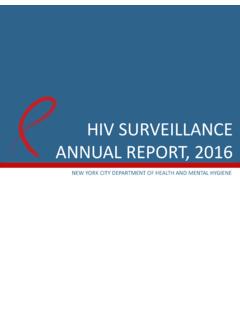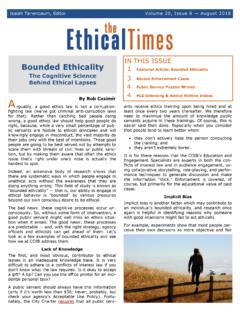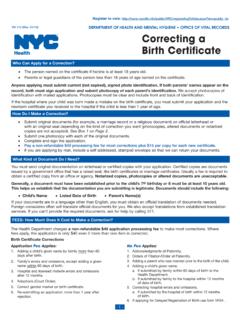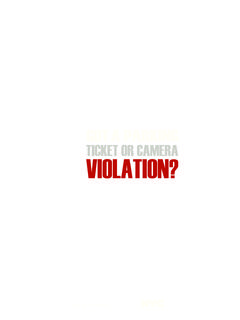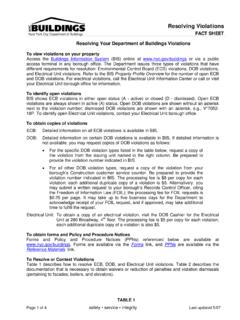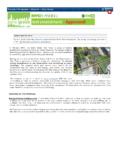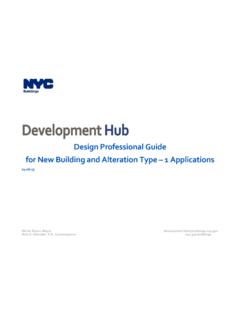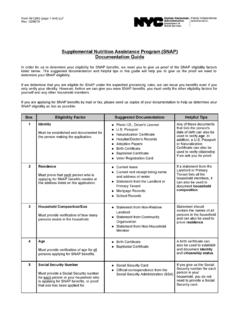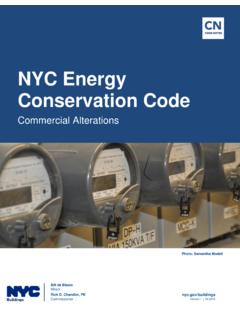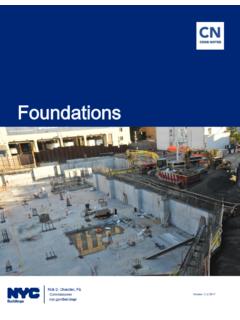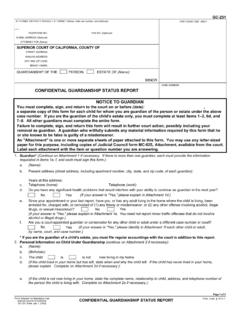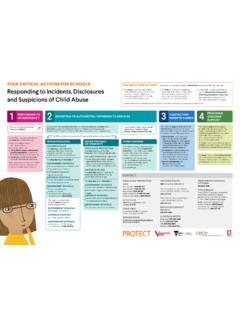Transcription of New York City Police Department Disciplinary System ...
1 New york city Police Department Disciplinary System Penalty Guidelines Effective January 15, 2021 i Table of Contents Police Commissioner s Letter .. 1 Introduction .. 2 NYPD Values .. 2 Neighborhood Policing and the Disciplinary System .. 2 The Disciplinary System .. 3 Goals of the Disciplinary System .. 3 Discipline Generally .. 3 The Investigative Process .. 4 Intersection with the Criminal Justice 5 Statute of Limitations .. 6 Resolution of Disciplinary Charges .. 6 Police Commissioner s Authority .. 6 Settlement Agreements .. 6 Department Trials .. 6 Penalty Guidelines .. 8 The Penalty Guidelines Explained .. 8 Presumptive Penalties .. 8 Mitigating and Aggravating Factors .. 9 Potential Mitigating Factors .. 9 Potential Aggravating Factors .. 10 The Effect of Rank on Discipline .. 10 Prior Disciplinary History .. 11 Progressive Discipline .. 11 Consequences of Disciplinary Action.
2 12 Calculation of Penalties .. 12 Probationary Status .. 13 Effect of Precedent .. 14 Definitions .. 14 Additional Requirements .. 15 Specific Penalty Guidelines by Category .. 17 Conduct Constituting a Crime Proscribed State or Federal Law .. 17 Presumptive Penalties for Violation of Criminal Statutes .. 18 Use of Excessive Force .. 20 Additional Definitions Pertaining to Use of Force .. 20 Presumptive Penalties for Use of Excessive 22 ii Additional Potential Mitigating Factors .. 24 Additional Potential Aggravating Factors .. 24 Abuse of Authority, Discourtesy and Offensive Language .. 25 Additional Definitions .. 25 Presumptive Penalties for Abuse of Authority, Discourtesy, Offensive Language .. 26 Additional Potential Mitigating Factors .. 28 Additional Potential Aggravating Factors .. 28 False, Misleading and Inaccurate 29 Additional Definitions for False, Misleading and Inaccurate Statements .. 29 Presumptive Penalties for False, Misleading & Inaccurate Statements and Impeding an Investigation.
3 32 Additional Potential Aggravating Factors .. 32 Additional Potential Mitigating Factors .. 32 Domestic Violence Incidents .. 33 Additional Definition for Domestic Violence Incidents .. 33 Presumptive Penalties for Domestic Violence Incidents Involving Family/Household .. 33 Additional Considerations for Domestic Violence Incidents .. 34 Unique Aggravating Factors and Additional Presumptive Penalties for misconduct Involving Family/Household .. 35 Additional Potential Mitigating Factors .. 36 Driving While Ability Impaired/Intoxicated Incidents .. 37 Presumptive Penalties for Driving While Impaired/Intoxicated .. 37 Additional Considerations for DWI Incidents .. 37 Unique Aggravating Factors and Additional Presumptive Penalties .. 38 Firearm-Related Incidents .. 39 Presumptive Penalties for Firearm-Related Incidents .. 39 Ingesting Controlled Substances, Marihuana/THC, Banned Substances and Excessive/Unexcused Use of Prescription Drugs.
4 41 Additional Definitions .. 41 Presumptive Penalties for Controlled Substances, Marijuana/THC, Banned Substances and Excessive/Unexcused Use of Prescription Drugs .. 42 Violations of Department Rules and Regulations .. 43 Presumptive Penalties for Violation of Department Rules and Regulations Adjudicated by Charges and Specifications .. 43 Off-Duty misconduct & Prohibited Conduct Generally .. 46 Presumptive Penalties for Off-Duty misconduct & Prohibited Conduct .. 46 Equal Employment Opportunity Division and the Discipline System .. 48 Presumptive Penalties for Equal Employment Opportunity Violations .. 48 Protected Classes Pursuant to Federal, State, and Local Law (current as of June 16, 2020) .. 49 Additional Potential Aggravating Factors .. 49 misconduct Adjudicated by Command Discipline General Terms .. 50 Adjudicated by Schedule A Command Discipline .. 50 Adjudicated by Schedule B Command Discipline.
5 52 Adjudicated by Schedule C Command Discipline .. 52 Conclusion .. 54 January 15, 2021 In January 2019, a blue ribbon panel of judges and former prosecutors made 13 recommendations to improve the New york city Police Department s internal discipline process. The Department accepted them all, including the recommendation that we consider a discipline penalty matrix to outline the presumptive penalties for a wide variety of possible offenses both violations of internal Department rules and Police misconduct during encounters with members of the public. This document, almost two years in the making, is the product of that effort. Preparing the matrix turned out to be an extremely useful exercise. First, it gives the members of our Department and the members of the public a clearer understanding of how penalties will be imposed when officers are found guilty of, or plead guilty to, Disciplinary charges.
6 Second, the work of developing the matrix forced the Department to take a hard look at our discipline System . Like the blue ribbon panel, we found that the discipline System is generally robust, however, the analysis revealed some inconsistencies and oversights that diminished the System s fairness and efficacy in the eyes of both the public and our own employees. In retrospect, the matrix was long overdue and has proven a very welcome improvement. The revision process has been a collaborative effort with a wide variety of Police oversight entities, public interest groups, elected leaders, and other interested parties. The final product relies heavily on public comments gathered from August to October of last year. In light of those comments, the Department strengthened the matrix in several key ways, namely: establishing greater consistency between penalties assessed for violating internal Department policies and penalties imposed for Police misconduct in public encounters, defining clear escalating penalties for repeat offenders, and delineating more specifically how both mitigating and aggravating factors may affect the ultimate penalties imposed.
7 In all, I believe this matrix with its detailed presumptive penalties for acts of misconduct will help to ensure that the NYPD discipline System does what it is intended to do: punish officers who have abused their position of trust in a fair manner and apply a consistent approach to both appropriate penalties and, in some instances, provide for remedial education and rehabilitation of offending officers that deters and prevents future wrongdoing. Our goal is to always strive to ensure that our discipline System is as clear and fair as it can be, and we believe that this product is another important step toward achieving that goal. We also recognize that this matrix is a living document, which may, and should, be revised as part of a continuing process of review, assessment, and improvement of the entire Disciplinary System in the coming years. Sincerely, Dermot Shea Police Commissioner 2 Introduction New york city Police officers hold a unique position within our society.
8 They are responsible for the safety and security of all of those who work, live and visit our city . Whether responding to crimes in progress or offering emergency assistance, they are the component of government that civilians most frequently interact with and rely upon in times of need. In order to effectively carry out their duties, Police officers are granted vast discretion in how exactly to perform their work. They have the power to seize property, restrict the freedom of individuals, and, under appropriate circumstances, to use force in the course of their duties. With this discretion comes a responsibility to perform their duties using good judgment and exercise their discretion within the bounds of the law and New york city Police Department ( NYPD ) policy. Both the public and Police officers must understand and, indeed expect, that when the bounds of the law or Department policy are exceeded, equitable discipline will result.
9 Similarly, it should be expected that any discipline imposed will be fair, consistent and based upon reasonable standards. Fairness within a Disciplinary System begins with taking the time to objectively review the totality of the circumstances surrounding any substantiated misconduct . Proportionality of discipline requires that each instance of misconduct is addressed in line with the seriousness of that misconduct , including any aggravating and mitigating circumstances. Lastly, equity within a discipline System means that every officer is held accountable for unacceptable behavior, without regard to rank, title, demographic identity, assignment, or membership in any protected class. It is with these tenets in mind that these Penalty Guidelines ( Guidelines ) have been assembled and published. Nothing in these Guidelines shall be construed to limit the discretion of the Police Commissioner to impose discipline.
10 The Police Commissioner may modify these Guidelines as appropriate to address emerging issues and advance the goals of the Disciplinary System described herein. Any such modifications shall be posted on the Department s website, with an accompanying description of the modifications, as needed. No later than January 30, 2022 and by January 30 of each year thereafter, the Department shall post on its website and deliver to the Speaker of the New york city Council a report that includes the number and percentage of instances within the preceding calendar year in which the Police Commissioner imposed a Disciplinary penalty that deviates from the penalties enumerated in these NYPD Values The NYPD values provide the foundation for the Department s Disciplinary System . Given these values, the standards for professional and personal conduct are high. The Department has pledged that, in partnership with the community, it will: Protect the lives and property of our fellow citizens and impartially enforce the law Fight crime, both by preventing it and aggressively pursuing violators of the law Maintain a higher standard of integrity than is generally expected of others because so much is expected of us Value human life, respect the dignity of each individual, and render our services with courtesy and civility Neighborhood Policing and the Disciplinary System Neighborhood Policing is the cornerstone of the NYPD.
